Question
Fitzgerald's 35-year bonds pay 11 percent interest annually on a $1,000 par value. If the bonds sell at 935, what is the bond's yield to
Fitzgerald's 35-year bonds pay 11 percent interest annually on a $1,000 par value. If the bonds sell at 935, what is the bond's yield to maturity? What would be the yield to maturity if the bonds paid interest semiannually? Explain the difference.
A bond's market price is $750. It has a $1,000 par value, will mature in 6 years, and has a coupon interest rate of 9 percent annual interest, but makes its interest payments semiannually. What is the bond's yield to maturity? What happens to the bond's yield to maturity if the bond matures in 12 years? What if it matures in 3 years?
The market price is $925 for a 17-year bond ($1,000 par value) that pays 8 percent annual interest, but makes interest payments on a semiannual basis (4 percent semiannually). What is the bond's yield to maturity?
Pybus, Inc. is considering issuing bonds that will mature in 18 years with an annual coupon rate of 6 percent. Their par value will be $1,000, and the interest will be paid semiannually. Pybus is hoping to get a AA rating on its bonds and, if it does, the yield to maturity on similar AA bonds is 9 percent. However, Pybus is not sure whether the new bonds will receive a AA rating. If they receive an A rating, the yield to maturity on similar A bonds is 10 percent. What will be the price of these bonds if they receive either an A or a AA rating?
Step by Step Solution
There are 3 Steps involved in it
Step: 1

Get Instant Access to Expert-Tailored Solutions
See step-by-step solutions with expert insights and AI powered tools for academic success
Step: 2

Step: 3

Ace Your Homework with AI
Get the answers you need in no time with our AI-driven, step-by-step assistance
Get Started


